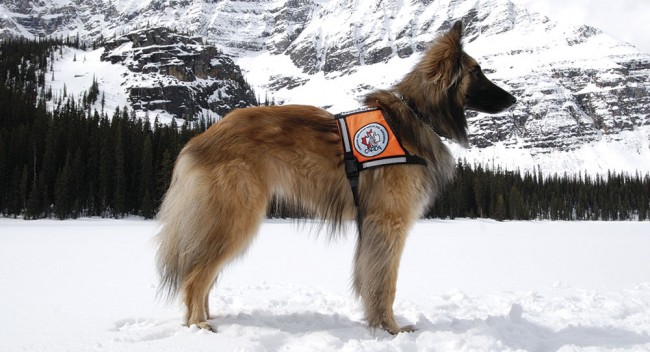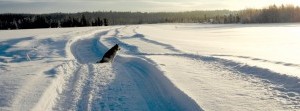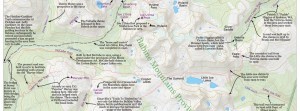
Photo Credit: Christopher Mclean
A nose in the snow: How avalanche dogs are making the northern backcountry safer
Stewart-based Canadian Avalanche Rescue Dog Association (CARDA) handler Bree Stefanson remembers the first time she and her four-legged companion responded to an avalanche independently.
“I was working on a ski hill. That day we were closing several areas due to snow pack conditions and I was just two towers from getting off the chairlift to close another ski area when I got a call that the area had avalanched and a family of five was under the debris pile,” she remembers. They searched the area, but found nothing. “My dog didn’t pick anything up and I organized a probe line to be sure. As we were probing, I realized that the person who triggered the avalanche was in the probe line, so I questioned him.”
As it turned out, the family believed to be buried was watching the search unfold from the sidelines. No one else was buried.
“My dog was right on the first pass—there was nothing in there. All the training we did was really intense and high pressure, which helped me be very clear on the day I had to do it by myself. That day, I really learned how to trust my dog,” she says.
Certified handlers and dogs play an important role in avalanche rescue and retrieval, and there’s more to being successful than just following their noses. For a handler and dog team, at least two years of coursework and training is needed before they are “validated,” or certified to work independently at a scene.
“It is a rigorous process,” says Smithers resident Christopher McLean, past CARDA member and owner of a retired dog. Dogs are accepted into the certification program between the ages of six months and two years, and not just any dog will do. “You need a dog that can handle -20 C for extended periods of time, has a high retrieve drive and a high work drive, and preferably a size you can pick up and carry or ski with, or put into a helicopter.”
McLean chose Chephren, a Belgian shepherd.
Search theory
To find a human buried in snow, dogs have to learn how to find a scent in the air and follow it through changing weather and snow conditions. McLean explains, “A living, breathing person emits a lot of scent all the time. The air picks it up and carries it in different patterns, depending on the weather and wind conditions. A strong wind draws the scent out in a long, thin ribbon, while a light breeze feathers it out in a broader path. Gusty winds blow it all over the place and it can be strong in one moment and gone in the next.”
This pattern is called a scent cone, and locating the scent cone is the dog’s main job. A reward system is used to train air scenting. High-drive dogs need a high-drive reward and this reward is called ragging, known to trainers as a high-energy game of tug-of-war.
“This is the ultimate search reward,” McLean says. “You need to get the dog excited to play this super-fun game of tug-of-war before the course. They have to think it is the best game ever, and reserved only for searches.”
The training process is a very structured series of search games. The handler first gins up the dog, or gets them excited, elevating their prey drive. Then he or she gives the leashed dog to another and runs off to hide. This hide-and-seek game gets progressively more difficult with longer time delays and also introduces other people to the mix so the dog has to find a person with an unfamiliar scent.
“This training can be difficult. Dogs are very smart and can outwit you during training. They can start tracking (following scent on the ground) instead of air scenting, which isn’t what you want,” McLean remarks. The final challenge is to find articles of scented clothing buried in the snow. As the articles are not alive, the scent is weak so they are harder to find. This mimics what it would be like to search for a body.
Training for handlers includes Canadian Avalanche Association (CAA) Avalanche Operations Level 1, a Ground Search and Rescue ticket from the Justice Institute and an 80-hour first aid course. Once complete, dog and handler are tested by the RCMP and CARDA. They have to demonstrate a search standard, an obedience standard and a mountain-travel standard. Dog and handler must be revalidated every year and take a course every second year to stay current.
Search practice
Bree Stefanson has been working with her dog, Aurora, for three years.
“When I’m called to a search I confirm with the RCMP dog handler that I can attend. We have to make sure the scene is safe; that’s our first priority. An assessment is done, then avalanche control if needed, and then the dog is put out on the deposit,” she says, referring to the debris that remains after an avalanche.
When a handler and dog search a deposit, they work independently. The handler does a hasty search with a transceiver and probe and looks for clues, such as clothing. The dog is searching independently, air scenting and working its way across the deposit.
“For many of the searches I’ve been on, you have to do it all: make sure the scene is safe, organize people, work your dog and run a transceiver and probe,” she says. “When we have more than one handler, we split the deposit up depending on how the dogs interact. When we train, the dogs can get very possessive of the article they are searching for and not want anyone else to get it, so it can be important to keep the dogs separate.”
The movement in a dog’s ears, nose and tail also help communicate how the search is going: “You really have to watch your dog because their body language is incredible,” Stefanson says.
Search motivation
Since being a dog handler is a volunteer position, one with an incredible amount of preparation and work, you could say that McLean and Stefanson have high service drives. Between courses, they keep their dogs working on their skills. It is clear that helping others is what keeps them practising.
“It isn’t going to be a happy day by the time I’ve been called out to a search. Time is working against you. For me, it is about bringing closure to the family. Instead of exposing a whole bunch of people and having extensive long searches and probe lines, I can put a dog on there and get the job done,” Stefanson says.
In addition to search events, McLean and Stefanson have independently participated in several demonstrations to community groups, Scout troops and classrooms to bring attention to mountain travel safety.
“We speak about avalanche awareness and how a dog uses its nose. We talk about avalanche hazards on ski hills and dangers of skiing out of bounds. The dogs provide a good entry point to encourage education and safety,” Stefanson says.
The pair helped start the Northwest BC Search and Rescue Dog Association to support local handler and dog teams by providing equipment or helping with bursaries for courses and travel. It provides needed community support, assistance in training and motivation for members.
“It is an incredible group of people full of passion, drive and compassion,” Stefanson says. To learn more about the Canadian Avalanche Rescue Dog Association, visit www.carda.ca.






